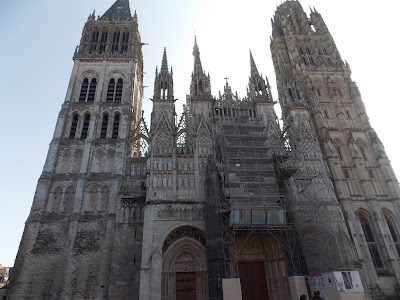It's the site of Joan of Arc's death (by being burned alive).
It's the home of the tallest cathedral in France (which was also the cathedral that Monet painted at all different hours in all different types of weather).
Most of the houses are made with wood timbers.
It was a large/wealthy city during the Middle Ages.
So first, that cathedral.
This cathedral is so immense that I have photos from all different sides. It's impossible to get it all into one frame.
I believe this is the side Monet used to paint.
This has got to be one of the unluckiest cathedrals in France. The building of the cathedral started in the 1100s, and the church got hit by lightning early on. Then in 1200 it burned down. Then it got hit by lightning again. Around 1350 the spire blew over. Then they did okay for about 150 years...and then the tower caught fire again. The 16th century brought the Wars of Religion, which majorly damaged the cathedral; the church pulled itself together in time to get hit by lightning again in 1625 and 1642 and then got badly damaged in a hurricane about four decades later. (What? There are hurricanes in France?) There was another fire before the French Revolution, during which the rebels came in and chopped statues heads off. Bear with me here, I'm almost done. The high spire was completely destroyed by yet another lightning strike in the 1800s and then the church was badly hurt during Allied bombings of France in the 1940s (much of the stained glass is gone). Finally, in the 1990s, there was a tornado that caused much of the roof to fall into the cathedral.
Whew.
For all I know, most enormous 900-year-old cathedrals have lots of bad luck as well, but this seems extreme. Anyway, there's a lot of construction going on at it at the moment - it's been almost constantly under construction for its entire existence. But it was still striking in its size and ornateness.
More shots of various sides of the cathedral.
Elaborate figures (which have been restored) over one of the entrances.
Some shots of the interior. The second is the ceiling under the tallest spire. SO HIGH.
In this photo you can clearly see up top that there is no more stained glass - it all got blown out by the seven bombs that hit the cathedral during the Allied bombings. Some of the lower stained glass (some of which is from the 1400s) has survived.
A model of the cathedral - the only way to show what it really looks like!
Go here to see some of Monet's paintings of the cathedral: http://en.wikipedia.org/wiki/Rouen_Cathedral_(Monet). We saw one of the paintings in the museum in Rouen.
Unsurprisingly, the cathedral dominates much of Rouen. There are several churches, but one of the other old and historical ones was completely under construction and impossible to access. So here are some of the other sites we saw:
Typical Rouen buildings - pretty! And very different than the buildings in Périgueux.
More typical buildings. Look at the old, fancy glass on the first building!
And, as the blog post title says, Rouen is also well-known because it is the site of the death of Joan of Arc. Joan of Arc was burned at the stake in 1431 (and then about 25 years later people basically said, "Oops. We messed up. She's okay." And they "rehabilitated" her - though she was still very dead.) The site of Joan of Arc's death is marked with a plaque, a cross, a statue, and a church.
The area where she was burned (le bûcher means the stake) and a sign commemorating the place.
And a sign on the old palais de justice explaining that it was the site of the trial that determined that Joan of Arc would be burned the next day at the market square. Quick turn around. There was a also a sign saying that in the same building a couple decades later they decided she wasn't a witch after all, but that one was less interesting.
And here are a few other things:
The "big clock." Very fancy, very pretty.
This is a courtyard on top of an old plague "cemetery" - which is really more of a mass grave. Some of the buildings around it are a school now! Creepy place for a school.
All around the walls there are carvings of skulls, bones, shovels, picks, etc. Very creepy.
I didn't take any pictures at it, but as I mentioned, we also went to the art museum and saw a lot of Impressionist paintings (the Impressionists really liked Rouen) and a bunch of other paintings. It was free for those under 25 - so totally worth it. But it was really quite cool to see the Monet paintings!
I liked Rouen. It was an interesting place, though I'm glad we only decided on one day here. We wouldn't have needed more time! Tomorrow morning we're off to Caen!



















No comments:
Post a Comment